Features
I’ve witnessed a coup attempt before — and history bodes poorly for America’s future

by Alfred Mccoy, Tom Dispatch
As an eyewitness, I can recall the events of January 6th in Washington as if they were yesterday. The crowds of angry loyalists storming the building while overwhelmed security guards gave way. The slavishly loyal vice-president who would, the president hoped, restore him to power. The crush of media that seemed confused, almost overwhelmed, by the crowd’s fury. The waiter who announced that the bar had run out of drinks and would soon be closing…
Hold it! My old memory’s playing tricks on me again. That wasn’t the U.S. Capitol in January 2021. That was the Manila Hotel in the Philippines in July 1986. Still, the two events had enough similarities that perhaps I could be forgiven for mixing them up.
I’ve studied quite a number of coups in my day, yet the one I actually witnessed at the Manila Hotel remains my favorite, not just because the drinks kept coming, but for all it taught me about the damage a coup d’état, particularly a political coup, can do to any democracy. In February 1986, a million Filipinos thronged the streets of Manila to force dictator Ferdinand Marcos into exile. After long years of his corruption and callous indifference to the nation’s suffering, the crowds cheered their approval when Marcos finally flew off to Hawaii and his opponent in the recent presidential election restored democracy.
But Marcos had his hard-core loyalists. One Sunday afternoon, four months after his flight, they massed in a Manila park to call for the restoration of their beloved president. After speakers had whipped the crowd of 5,000 into a frenzy with — and yes, this should indeed sound familiar in 2021 — claims about a stolen election, thousands of ordinary Filipinos pushed past security guards and stormed into the nearby Manila Hotel, a storied symbol of their country’s history. Tipped off by one of the Filipino colonels plotting that coup, I was standing in the hotel’s entryway at 5:00 p.m. as the mob, fury written on their faces, surged past me.
For the next 24 hours, that hotel’s marbled lobby became the stage for an instructive political drama. From my table at the adjoining bar, I watched as armed warlords, ousted Marcos cronies, and several hundred disgruntled soldiers paraded through the lobby on their way to the luxury suites where the coup commanders had checked themselves in. Following in their wake were spies from every nation — Australian secret intelligence, American defense intelligence, and their Asian and European counterparts — themselves huddled in groups, whispering mysteriously, trying (just like me) to make sense of the bizarre spectacle unfolding around them.
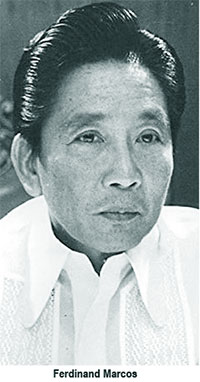 Later that same evening, Marcos’s former vice-president, the ever-loyal Arturo Tolentino, appeared at the head of the stairs flanked by a security detail to announce the formation of a “legitimate” new government authorized by Marcos who had reportedly called long-distance from Honolulu. As the vice president proclaimed himself acting president and read off the names of those to be in his cabinet, Filipino journalists huddling nearby scribbled notes. They were furiously trying to figure out whether there was a real coalition forming that could topple the country’s democracy. It was, however, just the usual suspects — Marcos cronies, leaders largely without followers.
Later that same evening, Marcos’s former vice-president, the ever-loyal Arturo Tolentino, appeared at the head of the stairs flanked by a security detail to announce the formation of a “legitimate” new government authorized by Marcos who had reportedly called long-distance from Honolulu. As the vice president proclaimed himself acting president and read off the names of those to be in his cabinet, Filipino journalists huddling nearby scribbled notes. They were furiously trying to figure out whether there was a real coalition forming that could topple the country’s democracy. It was, however, just the usual suspects — Marcos cronies, leaders largely without followers.
By midnight, the party was pretty much over. Our waiter, after struggling for hours to maintain that famed hotel’s standard of five-star service, apologized to our table of foreign correspondents because the bar had been drunk dry and was closing. Sometime before dawn, the hotel turned off the air conditioning, transforming those executive suites into saunas and, in the process, flushing out the coup plotters, their hangers-on, and most of the soldiers.
All day long, on the city’s brassy talk-radio stations and in the coffee shops where insiders gathered to swap scuttlebutt, Marcos’s loyalists were roasted, even mocked. The troops that had rallied to his side were sentenced to 30 push-ups on the parade ground — a source of more mirth. For spies and correspondents alike, the whole thing seemed like a one-day wonder, barely worth writing home about.
But it wasn’t. Not by a long shot. A coterie of colonels deep inside the Defense Ministry, my source among them, had observed that comedic coup attempt all too carefully and concluded that it had actually been a near-miss.
A year later, I found myself standing in the middle of an eight-lane highway outside the city’s main military cantonment, Camp Aguinaldo, ducking bullets from rebel soldiers who had seized the base and watching as government Marines and dive bombers attacked. This time, however, those colonels had launched a genuine coup attempt. No drinks. No waiters. No wisecracks. Just a day of bombs and bullets that crushed the plotters, leaving the country’s military headquarters a smoking ruin.
Two years later, the same coup colonels were back again for another attempt, leading 3,000 rebel troops in a multipronged attack on a capital that trembled on the brink of surrender. As a cavalcade of rebel armor drove relentlessly toward the presidential palace with nothing in their way, American President George H.W. Bush took a call aboard Air Force One over the Atlantic about a desperate request from his Philippine counterpart and ordered a pair of U.S. Air Force jet fighters to make a low pass over the rebel tanks and trucks. They got the message: turn back or be bombed into extinction. And so Philippine democracy was allowed to survive for another 30 years.
Message from the Manila Hotel
The message for democracy offered from the Manila Hotel was clear — so clear, in fact, that it helps explain the meaning of tangled events in Washington more than 30 years later. Whether it’s a poor country like the Philippines or a superpower like the United States, democracy is a surprisingly fragile construct. Its worst enemy is often an ousted ex-president, angry over his humiliation and perfectly willing to destroy the constitutional order to regain power.
No matter how angry such an ex-president might be, however, his urge for a political coup can’t succeed without the help of raw force, whether from a mob, a disgruntled military, or some combination of the two. The Manila Hotel coup teaches us one other fundamental thing: that coups need not be carefully planned. Most start with a handful of conspirators plotting some symbolic attack meant to shake the constitutional order, while hoping to somehow stall the security services for a few critical hours — just long enough for events to cascade spontaneously into a desired government collapse.
Whether in Manila or Washington, coup plotting usually starts right at the top. Just after the news networks announced that he had lost the election last November, Donald Trump launched a media blitz with spurious claims of “fraud on the American public,” firing off 300 tweets in the next two weeks loaded with false charges of irregularities and sparking loud, long protests by his loyalists at vote-counting centers in Michigan and Arizona.
When that response got little traction and Biden’s majority kept climbing, Trump began exploring three alternate routes, any of which might have led to a constitutional coup — manipulating the Justice Department to delegitimize the election, rigging the ratification of electoral votes in Congress, and the paramilitary (or military) option. At a White House meeting on December 18th, Michael Flynn, Trump’s former national security advisor, urged the president to “invoke martial law as part of his efforts to overturn the election” and accused his staff of “abandoning the president,” sparking “screaming matches” in the Oval Office.
By January 3, rumors and reports of Trump’s military option were circulating so credibly around Washington that all 10 living former defense secretaries — Dick Cheney, Donald Rumsfeld, and Mark Esper, among them — published a joint appeal to the armed forces to remain neutral in the ongoing dispute over the election’s integrity. Reminding the troops that “peaceful transfers of power… are hallmarks of our democracy,” they added that “efforts to involve the U.S. armed forces in resolving election disputes” would be “dangerous, unlawful, and unconstitutional.” They warned the troops that any “military officials who direct or carry out such measures would be… potentially facing criminal penalties.” In conclusion, they suggested to Trump’s secretary of defense and senior staff “in the strongest terms” that “they must…refrain from any political actions that undermine the results of the election.”
To legitimate his claims of fraud, according to the New York Times, the president also tried — on nine separate occasions in December and January — to force the Justice Department to take actions that would “undermine an election result.” In response, a mid-ranking Trump loyalist at Justice, a nonentity named Jeffrey Clark, began pressuring his boss, the attorney-general, to write Georgia officials claiming they had found “significant concerns that may have impacted the outcome of the election.” But at a three-hour White House meeting on January 3rd, Acting Attorney General Jeffrey Rosen balked at this evidence-free accusation. Trump promptly suggested that he could be replaced by that mid-ranking loyalist who could then send the fraud letter to Georgia. The president’s own top appointees at Justice, along with the White House counsel, immediately threatened to resign en masse, forcing Trump to give up on such an intervention at the state level.
Next, he shifted his constitutional maneuvering to Congress where, on January 6th, his doggedly loyal vice president, Mike Pence, would be presiding over the ratification of results from the Electoral College. In this dubious gambit, Trump was inspired by a bizarre constitutional theory advanced by former Chapman University law professor John Eastman — that the “Constitution assigns the power to the Vice President as the ultimate arbiter.”
In this scenario, Pence would unilaterally set aside electoral votes from seven states with “ongoing disputes” and announce that Trump had won a majority of the remaining electors — making him once again president. But the maneuver had no basis in law, so Pence, after scrambling desperately and unsuccessfully for a legal justification of some sort, eventually refused to play along.
A Political Coup
With the constitutional option closed, Trump opted for a political coup, rolling the dice with raw physical force, much as Marcos had done at the Manila Hotel. The first step was to form a crowd with some paramilitary muscle to stiffen the assault to come. On December 19th, Trump called on his hard-core followers to assemble in Washington, ready for violence, tweeting: “Big protest in D.C. on January 6th. Be there, will be wild!”
Almost immediately, the Internet’s right-wing chat boards lit up and indeed their paramilitaries, the Proud Boys and Three Percenters militia, turned up in Washington on the appointed day, ready to rumble. After President Trump roused the crowd at a rally near the White House with rhetoric about a stolen election, a mob of some 10,000 marched on the Capitol Building.
Starting at about 1:00 p.m., the sheer size of the crowd and strategic moves by the paramilitaries in their ranks broke through the undermanned lines of the Capitol Police, breaching the building’s first-floor windows at about 2:10 p.m. and allowing protesters to start pouring in. Once the rioters had accomplished the unimaginable and seized the Capitol, they were fresh out of plans, reduced to marching through the corridors hunting legislators and trashing offices.
At 2:24 p.m., President Trump tweeted: “Mike Pence didn’t have the courage to do what should have been done to protect our Country.” On the far-right social media site Parler, his supporters began messaging the crowd to get the vice president and force him to stop the election results. The mob rampaged through the marbled halls shouting “Hang Mike Pence.” Hunkered down inside the Capitol, Representative Adam Kinzinger (R-Illinois) tweeted: “This is a coup attempt.”
At 2:52 p.m., Representative Abigail Spanberger (D-Virginia), a former CIA agent, tweeted from inside the barricaded House chamber: “This is what we see in failing countries. This is what leads to the death of democracy.”
At 3:30 p.m., a small squad of military police arrived at the Capitol, woefully inadequate reinforcements for the overwhelmed Capitol Police. Ten minutes later, the D.C. Council announced that the Defense Department had denied the mayor’s request to mobilize the local National Guard. While the crowd fumbled and fulminated, some serious people were evidently slowing the military’s response for just the few critical hours needed for events to cascade into something, anything, that could shake the constitutional order and slow the ratification of Joe Biden’s election.
In nearby Maryland, Republican Governor Larry Hogan had immediately mobilized his state’s National Guard for the short drive to the Capitol while frantically phoning Acting Secretary of Defense Christopher Miller, who repeatedly refused him permission to send in the troops. Inside the Pentagon, Lieutenant General Charles Flynn, the brother of the same Michael Flynn who had been pushing Trump to declare martial law, was participating in what CNN called those “key January 6th phone calls” that refused permission for the Guard’s mobilization.
Following a phone call from the mayor of Washington and its police chief pleading for help, Secretary of the Army Ryan McCarthy “ran down the hall” of the Pentagon to get authorization for the Guard’s mobilization. After a crucial delay of 90 minutes, he finally called the Maryland governor, outside the regular chain of command, to authorize the Maryland Guard’s dispatch. Those would indeed be the first troops to arrive at the Capitol and would play a critical role in restoring order.
At about 4:30 p.m., Trump finally tweeted: “These are the things and events that happen when a sacred landslide election victory is so unceremoniously and viciously stripped away from great patriots who have been badly & unfairly treated for so long. Go home in love & peace.”
Ten minutes later, at 4:40 p.m., hundreds of riot personnel from the D.C. police, the FBI, and the Department of Homeland Security arrived, along with the Maryland Guard, to reinforce the Capitol Police. Within an hour, the protesters had been pushed out of the building and the Capitol was declared secure.
Just five days later, Dr. Fiona Hill, a senior Russia expert on the National Security Council under Trump, reviewed these events and concluded that President Trump had staged a coup “in slow motion… to keep himself in power.”
History’s Lessons
Beyond all the critical details of who did what and when, there were deeper historical forces at play, suggesting that Donald Trump’s urge for a political coup that would return him to power may be far from over. For the past 100 years, empires in decline have been roiled by coup attempts that sometimes have overturned constitutional orders. As their military reverses accumulate, their privileged economic position erodes, and social tensions mount, a succession of societies in the grip of a traumatic loss of global power have suffered coups, successful or not, including Great Britain, France, Portugal, Spain, the Soviet Union, and now the United States.
Britain’s plot was a bit fantastical. Amid the painful, protracted dissolution of their empire, Conservative leaders plotted with top generals in 1968 to oust leftist Labour Prime Minister Harold Wilson by capturing Heathrow airport, seizing the BBC and Buckingham Palace, and putting Lord Mountbatten in power as acting prime minister. Britain’s parliamentary tradition simply proved too strong, however, and key principals in the plot quickly backed out.
In April 1974, while Portugal was fighting and losing three bitter anticolonial wars in Africa, a Lisbon radio station played the country’s entry in that year’s Eurovision Song Contest (“After the Farewell”) just minutes before midnight on an evening that had been agreed upon. It was the signal to the military and their supporters to overthrow the entrenched conservative government of that moment, a success which became known as the “Carnation Revolution.”
However, the parallels between January 6th and the fall of France’s Fourth Republic in the late 1950s are perhaps the most telling. After liberating Paris from Nazi occupation in August 1944, General Charles de Gaulle headed an interim government for 18 months. He then quit in a dispute with the left, launching him into a decade of political intrigue against the new Fourth Republic, whose liberal constitution he despised.
By the mid-1950s, France was reeling from its recent defeat in Indochina, while the struggle against Muslim revolutionaries in its Algerian colony in North Africa turned ever more brutal, marked as it was by scandals over the widespread French use of torture. Amid that crisis of empire, an anti-elite, anti-intellectual, antisemitic politician named Pierre Poujade launched a populist movement that sent 56 members to parliament in 1956, including Jean-Marie Le Pen, later founder of the far-right National Front.
Meanwhile, a cabal of politicians and military commanders plotted a coup to return General de Gaulle to power, thinking he alone could save Algeria for France. After an army junta seized control of Algiers, the capital of that colony, in May 1958, paratroopers stationed there were sent to capture the French island of Corsica and to prepare to seize Paris should the legislature fail to install de Gaulle as prime minister.
As the country trembled on the brink of a coup, de Gaulle made his dramatic entry into Paris where he accepted the National Assembly’s offer to form a government, conditional upon the approval of a presidential-style constitution for a Fifth Republic. But when de Gaulle subsequently accepted the inevitability of Algeria’s independence, four top generals launched an abortive coup against him and then formed what they called the Secret Army Organization, or OAS. It would carry out terror attacks over the next four years, with 12,000 victims, while staging three unsuccessful assassination attempts against de Gaulle before its militants were killed or captured.
The Coup of 2024?
Just as the Filipino colonels spent five years launching a succession of escalating coups and those French generals spent four years trying to overthrow their government, so Trump’s Republicans are working with ferocious determination in the run-up to the 2022 and 2024 elections to ensure that their next constitutional coup succeeds. Indeed, if you look back on events over the past year through the prism of such historical precedents, you can see all the components for a future political coup falling into place.
No matter how improbable, discredited, or bizarre those election fraud claims are, Republican loyalists persist in endless ballot audits in Arizona, Wisconsin, Pennsylvania, Georgia, and Texas. Their purpose is not really to find more votes for Trump in the 2020 election, but to maintain at least the present level of rage among the one-third of all Americans and more than half of all Republicans who believe that Joe Biden’s presidency is fraudulent.
Since the 2020 election coincided with the new census, Republicans have been working, reports Vox news, to “gerrymander themselves into control of the House of Representatives.” Simultaneously, Republican legislators in 19 states have passed 33 laws making it more difficult for certain of their residents to vote. Driven by the white nationalist “replacement theory” that immigrants and people of color are diluting the pool of “real American” voters, Trump and his Republican loyalists are fighting for “ballot integrity” on the principle that all non-white votes are inherently illegitimate. As Trump put it on the stump in 2016:
“I think this will be the last election that the Republicans have a chance of winning because you’re going to have people flowing across the border, you’re going to have illegal immigrants coming in… and they’re going to be able to vote and once that all happens you can forget it. You’re not going to have one Republican vote.”
In case all that electoral manipulation fails and Trump needs more muscle for a future political coup, right-wing fighters like the Proud Boys are still rumbling away at rallies in Oregon, California, and elsewhere across America. Just as the Philippine government made military rebels do a risible 30 push-ups for the capital crime of armed rebellion, so federal courts have generally been handing out the most modest of penalties to rioters who attempted nothing less than the overthrow of U.S. constitutional democracy last January 6th.
Among the 600 rioters arrested as of August, dozens have been allowed to plead guilty to misdemeanors and only three had been sentenced to jail time, leaving most cases languishing in pretrial motions. Already Republicans like Senator Ted Cruz have rallied to their defense, writing the U.S. attorney general to complain about an “unequal administration of justice” with “harsher treatment” for Capitol defendants than those arrested in Black Lives Matter protests.
So, in 2024, as the continuing erosion of America’s global power creates a crisis of confidence among ordinary Americans, expect Donald Trump to be back, not as the slightly outrageous candidate of 2016 or even as the former president eager to occupy the White House again, but as a militant demagogue with thundering racialist rhetoric, backed by a revanchist Republican Party ready, with absolute moral certainty, to bar voters from the polls, toss ballots out, and litigate any loss until hell freezes over.
And if all that fails, the muscle will be ready for another violent march on Washington. Be prepared, the America we know is worsening by the month.
Features
Wishes, Resolutions and Climate Change

Exchanging greetings and resolving to do something positive in the coming year certainly create an uplifting atmosphere. Unfortunately, their effects wear off within the first couple of weeks, and most of the resolutions are forgotten for good. However, this time around, we must be different, because the nation is coming out of the most devastating natural disaster ever faced, the results of which will impact everyone for many years to come. Let us wish that we as a nation will have the courage and wisdom to resolve to do the right things that will make a difference in our lives now and prepare for the future. The truth is that future is going to be challenging for tropical islands like ours.
We must not have any doubts about global warming phenomenon and its impact on local weather patterns. Over its 4.5-billion-year history, the earth has experienced drastic climate changes, but it has settled into a somewhat moderate condition characterised by periods of glaciation and retreat over the last million years. Note that anatomically modern Homo sapiens have been around only for two to three hundred thousand years, and it is reasoned that this stable climate may have helped their civilisation. There have been five glaciation periods over the last five hundred thousand years, and these roughly hundred-thousand-year cycles are explained by the astronomical phenomenon known as the Milankovitch Cycle (the lows marked with stars in Figure 1). At present, the earth is in an inter glacial period and the next glaciation period will be in about eighty thousand years.
 (See Figure 1. Glaciation Cycles)
(See Figure 1. Glaciation Cycles)
During these cycles, the global mean temperature has changed by about 7-8 degrees Centigrade. In contrast to this natural variation, earth has been experiencing a rapid temperature increase over the past hundred years. There is ample scientific evidence from multiple sources that this is caused by the increase in carbon dioxide gas in the atmosphere, which has seen a 50% increase over the historical levels in just hundred years (Figure 2). Carbon dioxide is one of the greenhouse gases which traps heat from the sun and slows the natural cooling process of the earth. This increase of carbon dioxide is due to human activities: fossil fuel burning, industrial processes, deforestation, and agricultural practices. Ironically, those who suffer from the consequences did not contribute to these changes; those who did contribute are trying their best to convince the world that the temperature changes we see are natural, and nothing should be done. We must have no illusions that global warming is a human-caused phenomenon, and it has serious repercussions.
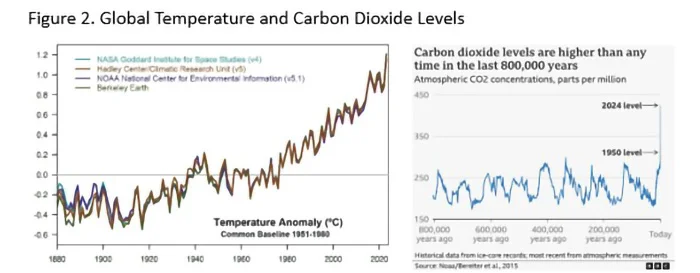
(See Figure 2. Global Temperature and Carbon Dioxide Levels)
Why should we care about global warming? Well, there are many reasons, but let us focus on earth’s water cycle. Middle schoolers know that water evaporates from the oceans, rises into the atmosphere where it cools, condenses, and falls back onto earth as rain or snow. When the oceans warm, the evaporation increases, and the warmer atmosphere can hold more water vapour. Water laden atmosphere results in severe and erratic weather. Ironically, water vapour is also a greenhouse gas, and this has a snowballing effect. The increased ocean temperature also disrupts ocean currents that influence the weather on land. The combined result is extreme and severe weather: violent storms and droughts depending on the geographic location. What is happening on the West coast of the USA is an example. The net result will be major departures from what is considered normal weather over millennia.
International organisations have been talking for 30 years about limiting global temperature increase to 1.5oC above pre-industrial levels by curtailing greenhouse gas emissions. But not much has been done and the temperature has risen by 1.2oC already. The challenge is that even if we can stop greenhouse gas emissions completely, right now, we have the problem of removing already existing 2,500 billion tons of carbon from the atmosphere, for which there are no practical solutions yet. Scientists worry about the consequences of runaway temperature increase and its effect on human life, which are many. It is not a doomsday prediction of life disappearing from earth, but a warning that life will be quite different from what humans are used to. All small tropical nations like ours are burdened with mitigating the consequences; in other words, get ready for more Ditwahs, do not wait for the twelve-day forecast.
Some opined that not enough warning was given regarding Ditwah; the truth is that the tools available for long-term prediction of the path or severity of a weather event (cyclone, typhoon, hurricane, tornado) are not perfect. There are multitude of rapidly changing factors contributing to the behavior of weather events. Meteorologists feed most up to date data to different computer models and try to identify the prediction with the highest probability. The multiple predictions for the same weather event are represented by what is known as spaghetti plots. Figure 3 shows the forecasted paths of a 2019 Atlantic hurricane five days ahead on the right and the actual path it followed on the left. While the long-term prediction of the path of a cyclone remains less accurate, its strength can vary within hours. There are several Indian ocean cyclones tracking sites online accessible to the public.

Figure 3. Forecasting vs Reality
There is no argument that short-term forecasts of this nature are valuable in saving lives and movable assets, but having long term plans in place to mitigate the effects of natural disasters is much more important than that. If a sizable section of the population must start over their lives from ground zero after every storm, how can a country economically develop?
The degree of our unpreparedness came to light during Ditwah disaster. It is not for lack of awareness; judging by the deluge of newspaper articles, blogs, vlogs, and speeches made, there is no shortage of knowledge and technical expertise to meet the challenge. The government has assured the necessary resources, and there is good reason to trust that the funds will be spent properly and not to line the pockets as happened during previous disasters. However, history tells us that despite the right conditions and good intentions, we could miss the opportunity again. Reasons for such skepticisms emerged during the few meetings the President held with the bureaucrats while visiting effected areas. Also, the COPE committee meetings plainly display the inherent inefficiencies and irregularities of our system and the absence of work ethics among all levels of the bureaucracy.
What it tells us is that we as a nation have an attitude problem. There are ample scholarly analyses by local as well as international researchers on this aspect of Sri Lankan psyche, and they label it as either island or colonial mentality. The first refers to the notion of isolated communities perceiving themselves as exceptional or superior to the rest of the world, and that the world is hell-bent on destroying or acquiring what they have. This attitude is exacerbated by the colonial mentality that promoted the divide and conquer rules and applied it to every societal characteristic imaginable; and plundered natural resources. As a result, now we are divided along ethnic, linguistic, religious, political, class, caste, geography, wealth, and many more real and imagined lines. Sadly, politicians, some religious leaders, and other opportunists keep inflaming these sentiments for their benefit when most of the population is willing to move on.
The first wish, therefore, is to get the strength, courage, and wisdom to think rationally, and discard outdated and outmoded belief systems that hinder our progress as a nation. May we get the courage to stop venerating elite who got there by exploiting the masses and the country’s wealth. More importantly, may we get the wisdom to educate the next generation to be free thinkers, give them the power and freedom to reject fabrications, myths, and beliefs that are not based on objective facts.
This necessitates altering our attitude towards many aspects of life. There is no doubt that free thinking does not come easily, it involves the proverbial ‘exterminating the consecrated bull.’ We are rightfully proud about our resplendent past. It is true that hydraulic engineering, art, and architecture flourished during the Anuradhapura period.
However, for one reason or another, we have lost those skills. Nowadays, all irrigation projects are done with foreign aid and assistance. The numerous replicas of the Avukana statue made with the help of modern technology, for example, cannot hold a candle to the real one. The fabled flying machine of Ravana is a figment of marvelous imagination of a skilled poet. Reality is that today we are a nation struggling with both natural and human-caused disasters, and dependent on the generosity of other nations, especially our gracious neighbor. Past glory is of little help in solving today’s problems.
Next comes national unity. Our society is so fragmented that no matter how beneficial a policy or an idea for the nation could be, some factions will oppose it, not based on facts, but by giving into propaganda created for selfish purposes. The island mentality is so pervasive, we fail to trust and respect fellow citizens, not to mention the government. The result is absence of long-term planning and stability. May we get the insight to separate policy from politics; to put nation first instead of our own little clan, or personal gains.
With increasing population and decreasing livable and arable land area, a national land management system becomes crucial. We must have an intelligent zoning system to prevent uncontrolled development. Should we allow building along waterways, on wetlands, and road easements? Should we not put the burden of risk on the risk takers using an insurance system instead of perpetual public aid programs? We have lost over 95% of the forest cover we had before European occupation. Forests function as water reservoirs that release rainwater gradually while reducing soil erosion and stabilizing land, unlike monocultures covering the hill country, the catchments of many rivers. Should we continue to allow uncontrolled encroachment of forests for tourism, religious, or industrial purposes, not to mention personal enjoyment of the elite? Is our use of land for agricultural purposes in keeping with changing global markets and local labor demands? Is haphazard subsistence farming viable? What would be the impact of sea level rising on waterways in low lying areas?
These are only a few aspects that future generations will have to grapple with in mitigating the consequences of worsening climate conditions. We cannot ignore the fact that weather patterns will be erratic and severe, and that will be the new normal. Survival under such conditions involves rational thinking, objective fact based planning, and systematic execution with long term nation interests in mind. That cannot be achieved with hanging onto outdated and outmoded beliefs, rituals, and traditions. Weather changes are not caused by divine interventions or planetary alignments as claimed by astrologers. Let us resolve to lay the foundation for bringing up the next generation that is capable of rational thinking and be different from their predecessors, in a better way.
by Geewananda Gunawardana
Features
From Diyabariya to Duberria: Lanka’s Forgotten Footprint in Global Science

For centuries, Sri Lanka’s biological knowledge travelled the world — anonymously. Embedded deep within the pages of European natural history books, Sinhala words were copied, distorted and repurposed, eventually fossilising into Latinised scientific names of snakes, bats and crops found thousands of kilometres away.
Africa’s reptiles, Europe’s taxonomic catalogues and global field guides still carry those echoes, largely unnoticed and uncredited.
Now, a Sri Lankan herpetologist is tracing those forgotten linguistic footprints back to their source.
Through painstaking archival research into 17th- and 18th-century zoological texts, herpetologist and taxonomic researcher Sanjaya Bandara has uncovered compelling evidence that several globally recognised scientific names — long assumed to be derived from Greek or Latin — are in fact rooted in Sinhala vernacular terms used by villagers, farmers and hunters in pre-colonial Sri Lanka.
“Scientific names are not just labels. They are stories,” Bandara told The Island. “And in many cases, those stories begin right here in Sri Lanka.”

Sanjaya Bandara
At the heart of Bandara’s work is etymology — the study of word origins — a field that plays a crucial role in zoology and taxonomy.
While classical languages dominate scientific nomenclature, his findings reveal that Sinhala words were quietly embedded in the foundations of modern biological classification as early as the 1700s.
One of the most striking examples is Ahaetulla, the genus name for Asian vine snakes. “The word Ahaetulla is not Greek or Latin at all,” Bandara explained. “It comes directly from the Sinhala vernacular used by locals for the Green Vine Snake.” Remarkably, the term was adopted by Carl Linnaeus himself, the father of modern taxonomy.
Another example lies in the vespertilionid bat genus Kerivoula, described by British zoologist John Edward Gray. Bandara notes that the name is a combination of the Sinhala words kiri (milky) and voula (bat). Even the scientific name of finger millet, Eleusine coracana, carries linguistic traces of the Sinhala word kurakkan, a cereal cultivated in Sri Lanka for centuries.
Yet Bandara’s most intriguing discoveries extend far beyond the island — all the way to Africa and the Mediterranean.
In a research paper recently published in the journal Bionomina, Bandara presented evidence that two well-known snake genera, Duberria and Malpolon, both described in 1826 by Austrian zoologist Leopold Fitzinger, likely originated from Sinhala words.
The name Duberria first appeared in Robert Knox’s 1681 account of Ceylon, where Knox refers to harmless water snakes called “Duberria” by locals. According to Bandara, this was a mispronunciation of Diyabariya, the Sinhala term for water snakes.
“Mispronunciations are common in Knox’s writings,” Bandara said. “English authors of the time struggled with Sinhala phonetics, and distorted versions of local names entered European literature.”
Over time, these distortions became formalised. Today, Duberria refers to African slug-eating snakes — a genus geographically distant, yet linguistically tethered to Sri Lanka.
Bandara’s study also proposes the long-overdue designation of a type species for the genus, reviving a 222-year-old scientific name in the process.
Equally compelling is the case of Malpolon, the genus of Montpellier snakes found across North Africa, the Middle East and southern Europe. Bandara traced the word back to a 1693 work by English zoologist John Ray, which catalogued snakes from Dutch India — including Sri Lanka.
“The term Malpolon appears alongside Sinhala vernacular names,” Bandara noted. “It is highly likely derived from Mal Polonga, meaning ‘flowery viper’.” Even today, some Sri Lankan communities use Mal Polonga to describe patterned snakes such as the Russell’s Wolf Snake.
Bandara’s research further reveals Sinhala roots in the African Red-lipped Herald Snake (Crotaphopeltis hotamboeia), whose species name likely stems from Hothambaya, a regional Sinhala term for mongooses and palm civets.
“These findings collectively show that Sri Lanka was not just a source of specimens, but a source of knowledge,” Bandara said. “Early European naturalists relied heavily on local names, local guides and local ecological understanding.”
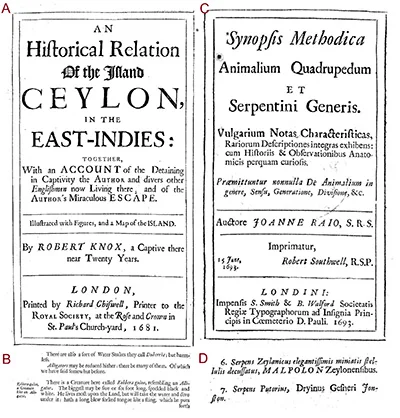 Perhaps the most frequently asked question Bandara encounters concerns the mighty Anaconda. While not a scientific name, the word itself is widely believed to be a corruption of the Sinhala Henakandaya, another snake name recorded in Ray’s listings of Sri Lankan reptiles.
Perhaps the most frequently asked question Bandara encounters concerns the mighty Anaconda. While not a scientific name, the word itself is widely believed to be a corruption of the Sinhala Henakandaya, another snake name recorded in Ray’s listings of Sri Lankan reptiles.
“What is remarkable,” Bandara reflected, “is that these words travelled across continents, entered global usage, and remained there — often stripped of their original meanings.”
For Bandara, restoring those meanings is about more than taxonomy. It is about reclaiming Sri Lanka’s rightful place in the history of science.
“With this study, three more Sinhala words formally join scientific nomenclature,” he said.
“Who would have imagined that a Sinhala word would be used to name a snake in Africa?”
Long before biodiversity hotspots became buzzwords and conservation turned global, Sri Lanka’s language was already speaking through science — quietly, persistently, and across continents.
By Ifham Nizam
Features
Children first – even after a disaster

However, the children and their needs may be forgotten after a disaster.
Do not forget that children will also experience fear and distress although they may not have the capacity to express their emotions verbally. It is essential to create child-friendly spaces that allow them to cope through play, draw, and engage in supportive activities that help them process their experiences in a healthy manner.
The Institute for Research & Development in Health & Social Care (IRD), Sri Lanka launched the campaign, titled “Children first,” after the 2004 Tsunami, based on the fundamental principle of not to medicalise the distress but help to normalise it.

The Island picture page
The IRD distributed drawing material and play material to children in makeshift shelters. Some children grabbed drawing material, but some took away play material. Those who choose drawing material, drew in different camps, remarkably similar pictures; “how the tidal wave came”.
“The Island” supported the campaign generously, realising the potential impact of it.
The campaign became a popular and effective public health intervention.
“A public health intervention (PHI) is any action, policy, or programme designed to improve health outcomes at the population level. These interventions focus on preventing disease, promoting health, and protecting communities from health threats. Unlike individual healthcare interventions (treating individuals), which target personal health issues, public health interventions address collective health challenges and aim to create healthier environments for all.”
The campaign attracted highest attention of state and politicians.
The IRD continued this intervention throughout the protracted war, and during COVID-19.
The IRD quick to relaunch the “children first” campaign which once again have received proper attention by the public.
While promoting a public health approach to handling the situation, we would also like to note that there will be a significant smaller percentage of children and adolescents will develop mental health disorders or a psychiatric diagnosis.
We would like to share the scientific evidence for that, revealed through; the islandwide school survey carried out by the IRD in 2007.
 During the survey, it was found that the prevalence of emotional disorder was 2.7%, conduct disorder 5.8%, hyperactivity disorder was 0.6%, and 8.5% were identified as having other psychiatric disorders. Absenteeism was present in 26.8%. Overall, previous exposure to was significantly associated with absenteeism whereas exposure to conflict was not, although some specific conflict-related exposures were significant risk factors. Mental disorder was strongly associated with absenteeism but did not account for its association with tsunami or conflict exposure.
During the survey, it was found that the prevalence of emotional disorder was 2.7%, conduct disorder 5.8%, hyperactivity disorder was 0.6%, and 8.5% were identified as having other psychiatric disorders. Absenteeism was present in 26.8%. Overall, previous exposure to was significantly associated with absenteeism whereas exposure to conflict was not, although some specific conflict-related exposures were significant risk factors. Mental disorder was strongly associated with absenteeism but did not account for its association with tsunami or conflict exposure.
The authors concluded that exposure to traumatic events may have a detrimental effect on subsequent school attendance. This may give rise to perpetuating socioeconomic inequality and needs further research to inform policy and intervention.
Even though, this small but significant percentage of children with psychiatric disorders will need specialist interventions, psychological treatment more than medication. Some of these children may complain of abdominal pain and headaches or other physical symptoms for which doctors will not be able to find a diagnosable medical cause. They are called “medically unexplained symptoms” or “somatization” or “bodily distress disorder”.
Sri Lanka has only a handful of specialists in child and adolescent psychiatric disorders but have adult psychiatrists who have enough experience in supervising care for such needy children. Compared to tsunami, the numbers have gone higher from around 20 to over 100 psychiatrists.
Most importantly, children absent from schools will need more close attention by the education authorities.
In conclusion, going by the principles of research dissemination sciences, it is extremely important that the public, including teachers and others providing social care, should be aware that the impact of Cyclone Ditwah, which was followed by major floods and landslides, which is a complex emergency impact, will range from normal human emotional behavioural responses to psychiatric illnesses. We should be careful not to medicalise this normal distress.
It’s crucial to recall an important statement made by the World Health Organisation following the Tsunam
Prof. Sumapthipala MBBS, DFM, MD Family Medicine, FSLCFP (SL), FRCPsych, CCST (UK), PhD (Lon)]
Director, Institute for Research and Development in Health and Social Care, Sri Lanka
Emeritus Professor of Psychiatry, School of Medicine, Faculty of Medicine & Health Sciences, Keele University, UK
Emeritus Professor of Global Mental Health, Kings College London
Secretary General, International society for Twin Studies
Visiting Professor in Psychiatry and Biomedical Research at the Faculty of Medicine, Kotelawala Defence University, Sri Lanka
Associate Editor, British Journal Psychiatry
Co-editor Ceylon Medical Journal.
Prof. Athula Sumathipala
-

 News6 days ago
News6 days agoMembers of Lankan Community in Washington D.C. donates to ‘Rebuilding Sri Lanka’ Flood Relief Fund
-

 News4 days ago
News4 days agoBritish MP calls on Foreign Secretary to expand sanction package against ‘Sri Lankan war criminals’
-

 Features6 days ago
Features6 days agoGeneral education reforms: What about language and ethnicity?
-
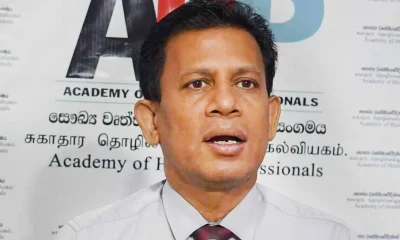
 News6 days ago
News6 days agoSuspension of Indian drug part of cover-up by NMRA: Academy of Health Professionals
-
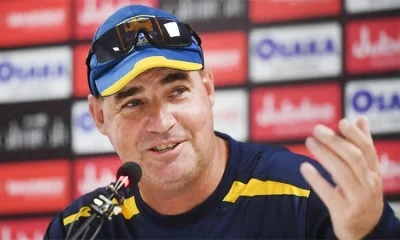
 Sports4 days ago
Sports4 days agoChief selector’s remarks disappointing says Mickey Arthur
-
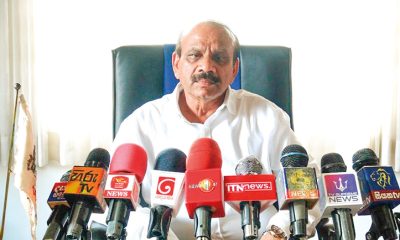
 News3 days ago
News3 days agoStreet vendors banned from Kandy City
-

 Editorial6 days ago
Editorial6 days agoA very sad day for the rule of law
-

 News6 days ago
News6 days agoUS Ambassador to Sri Lanka among 29 career diplomats recalled













